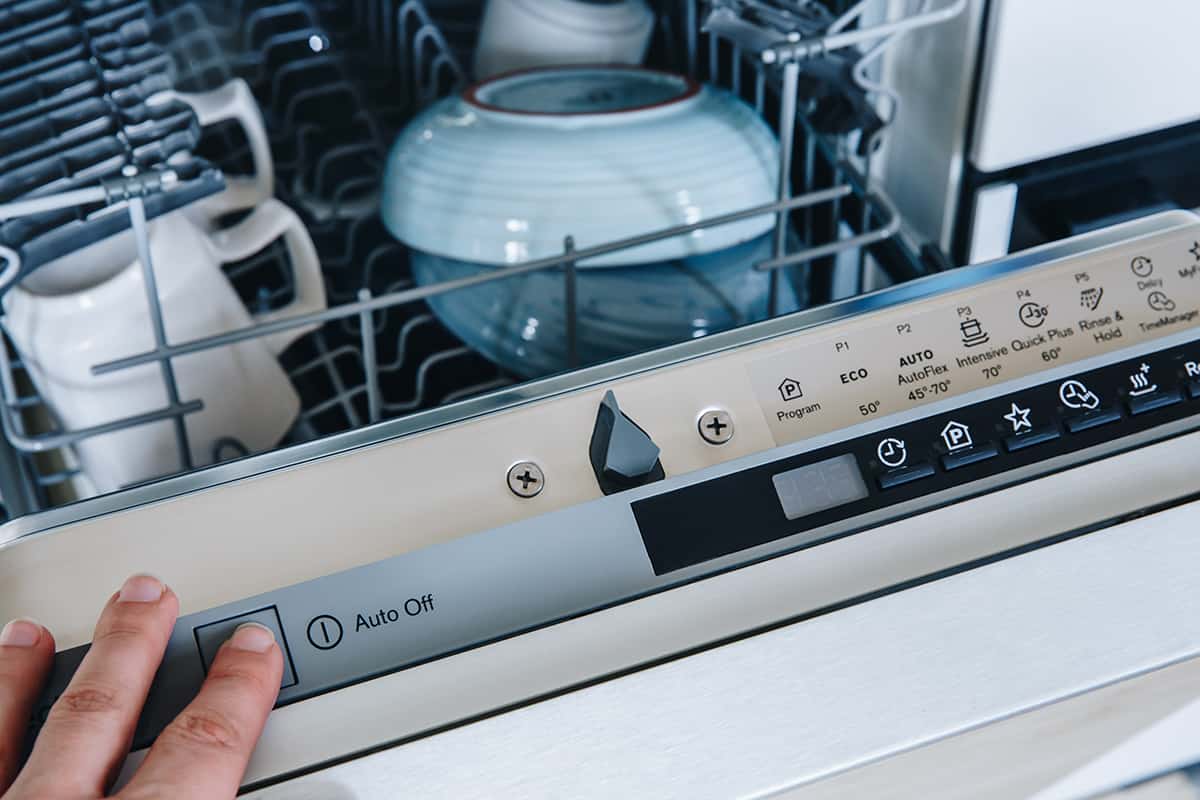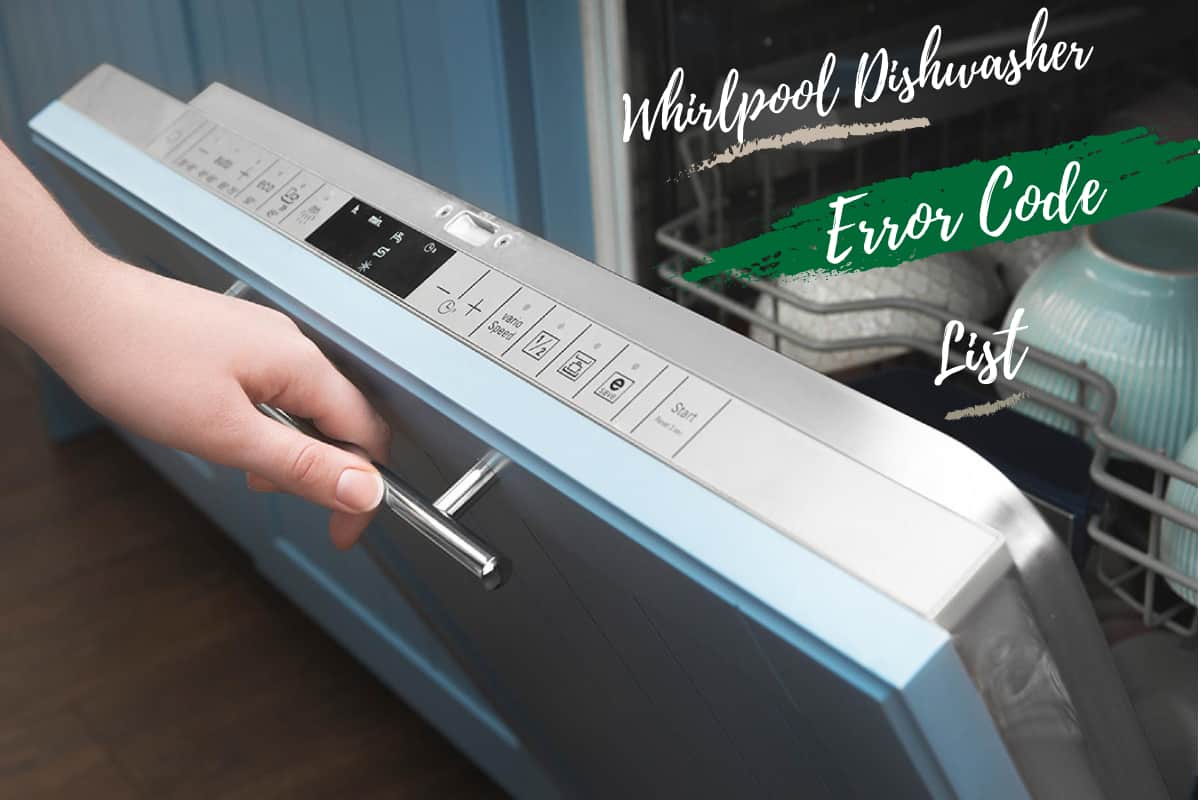Whirlpool dishwashers are among some of the most reliable out there. However, that doesn’t mean they’re indestructible! You may find an error code pop-up on display, and to resolve the problem, you need to figure out what the code means.
Error codes in Whirlpool dishwashers are displayed as F codes and numbers. The error code list is as follows:
- F1—Unusual water temperature
- F2—Leaks
- F3—Heating problems
- F4—Draining failure
- F5—Blocked rotor
- F6—Not receiving water
- F7—Abnormal water flow rate
- F8—Too much water
- F9—Continuous water intake
- F10 or F0—Faulty sensor(s)
Sometimes, you will need to run a diagnostic test to see the error code. In this guide, I’ll explain how to run the diagnostic test, as well as describe what the various error codes mean and how to resolve the problem.
How to Run a Diagnostic Test

The most common dishwasher problems are noticeable immediately. When you try to run the machine, an error code will pop up on the digital display, informing you what the problem is. And after you reset your dishwasher and see no effects. To get a more accurate idea of what the problem is, you should run a diagnostic test.
The diagnostic test in Whirlpool dishwashers is a self-administered evaluation of all of the appliance’s hardware. You need to enter the dishwasher into diagnostic mode to run this test, which can take anywhere from 5 to 30 minutes. After running the test, you’ll notice a series of letters and numbers that describe a specific issue.
But before we get there, we first need to figure out how to run a diagnostic test.
- Turn on the dishwasher.
- Open the door.
- Press any three keys on the control board in quick succession.
- Repeat the same button presses in the same order in quick succession two more times.
- Shut the door.
From there, it will take a few seconds for the dishwasher to enter diagnostic mode. You’ll know when the test has started when the dishwasher begins producing a buzzing noise. Do not interrupt the dishwasher until it shuts off automatically.
The exact methods of entering diagnostic mode vary from model to model. The best thing you can do is to open the owner’s manual to see how it’s done for your specific Whirlpool dishwasher.
Whirlpool Dishwasher Error Code List
Now, let’s see what sort of error codes show up and what you can do to fix the problem.
F1—Unusual water temperature
Whirlpool dishwashers come with temperature sensors that check for the temperature of incoming water. While the temperature sensor tolerates slightly colder or hotter water than normal, it will stop all operations if the water is 26.6°F or 185°F.
Solution #1: Check the temperature of your home’s water supply
Most dishwashers are connected to a hot water line. Set the temperature of your water heater within an optimal temperature range.
Solution #2: Replace the temperature sensor
In extreme cases, the temperature sensor may be faulty. In this case, you would need to open the dishwasher, remove the existing sensor, and install a new one. After picking up a compatible temperature sensor for your dishwasher, you can follow this video guide by PartSelect.
F2—Leaks
Water is somehow seeping out of the machine. This error code usually kicks in when the predetermined filling time as elapsed, but there isn’t enough water in the tub.
Solution #1: Replace the gasket
The gasket is the plastic or silicone seal around the dishwasher door. Water can leak out of the crack and trickle down to your floor. You will need to completely replace the gasket if it’s the cause of leaks.
Solution #2: Empty the filter assembly
One thing many people don’t know is that the filter assembly needs to be emptied. It can take anywhere from 1 to 5 wash cycles or more before the filter becomes clogged, based on your dishwashing habits.
Solution #3: Make sure the dishwasher sits flat on your kitchen floor
This is a stretch, but it’s something worth considering if this is the first time you’re using a Whirlpool dishwasher. If the machine isn’t sitting flat on the floor, water can leak out of the machine through the door. Play around with the dishwasher’s adjustable lets to keep it as parallel to the floor as possible.
F3—Heating problems
All Whirlpool dishwashers come with a built-in heating element that heats water to the optimal sanitizing temperature. If it takes too long to do this, you need to inspect the heating system.
Solution #1: Replace the heating element
The heating element is made up of a series of coils. If there’s a crack in the coil, it won’t heat up water efficiently. Replace the coil and run a test cycle to make sure the problem is gone.
Solution #2: Replace the temperature sensor
Refer to Solution #2 in the F1 error code description.
F4—Draining failure
This code indicates that your Whirlpool dishwasher isn’t flushing dirty water out at the right rate. This can lead to standing water, which can contribute to bacteria and mold growth inside your dishwasher.
Solution #1: Empty the filter assembly
Refer to Solution #2 in the F2 error code description.
Solution #2: Unblock the drain line
The dishwasher’s drain line is connected to your kitchen’s waste line, usually via the garbage disposal. Clear the drain line and garbage disposal, or replace the hose/pipe entirely.
Solution #3: Replace the drain pump
In extreme cases, the drain pump may be faulty, and you’ll need to install a new one. After picking up a replacement drain pump, follow the instructions in this video by RepariClinic.com.
F5—Blocked rotor
The rotor is the spinning portion of the fan. If you don’t remove debris from your dishwasher periodically, some of that debris might make its way into the dishwasher’s motor and block the rotor.
Solution: Check the motor
You’re going to need to crack open the dishwasher to gain access to the motor. Inspect the motor and remove any blockages. If there are none and the error code continues showing up, you may need to replace the motor completely.
F6—Not receiving water
If your dishwasher doesn’t receive water, it won’t start the wash cycle. The F6 error code means that there’s absolutely no water entering the dishwasher.
Solution #1: Check the inlet valve
Turn off the dishwasher, pull it forward, and inspect the inlet valve. If your dishwasher is older than 5 years, there’s a good chance the valve needs to be replaced.
Solution #2: Check the inlet hose
If you just set up your dishwasher after moving homes, you need to make sure the hose doesn’t have any kinks or tears. So, straighten the hose before trying to turn the machine back on. If that doesn’t work, inspect the hose for damage. You’ll have no choice but to replace a torn inlet hose.
F7—Abnormally low water flow rate
The F6 error code shows that the dishwasher is receiving no water at all. The F7 code, on the other hand, indicates that there is water entering the machine, but there’s not enough to fill the tub.
Solution #1: Check the inlet valve
Refer to Solution #1 in the F6 error code description.
Solution #2: Check the inlet hose
Refer to Solution #2 in the F6 error code description.
F8—Too much water
Dishwashers follow a predetermined time while also regulating the flow of water when filling. The F8 error code means that there’s a problem with the water flow rate and that the machine has too much water in the tub.
Solution #1: Check the inlet valve
Refer to Solution #1 in the F6 error code description.
Solution #2: Empty the filter assembly
Refer to Solution #2 in the F2 error code description.
Solution #3: Load your dishes properly
If your bowls and pots and facing upright in the dishwasher, they can hold onto too much water. During the subsequent filling phases, the water may pour out of these dishes, causing a false F8 code reading.
F9—Continuous water intake
If you thought filling the dishwasher tub with too much water was a problem, try not to be able to shut off the flow of water at all. This is what happens when the F9 code appears.
Solution #1: Check the inlet valve
Refer to Solution #1 in the F6 error code description.
Solution #2: Replace the drain pump
Refer to Solution #3 in the F4 error code description.
F10 or F0—Faulty sensor(s)
Whirlpool dishwashers come with a series of sensors that constantly measure water levels, detergent levels, dish weight, etc. If any of these sensors go haywire, you’ll find an F10 or F0 code on the dishwasher’s display.
Solution: Inspect the sensors one at a time
This may sound like an extreme solution because it is. There’s nothing you can do except open the dishwasher and inspect all of the sensors to see which one is faulty. You’ll need a multimeter to do this, or you could hire a professional to do it for you.






